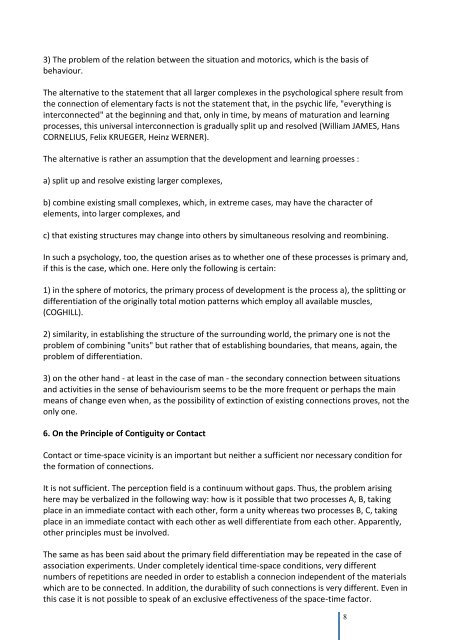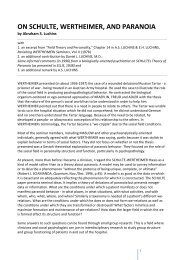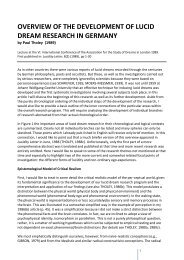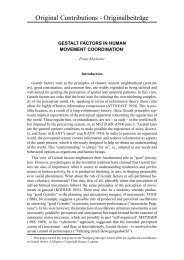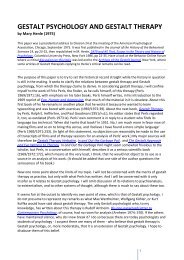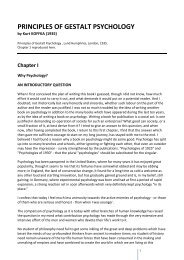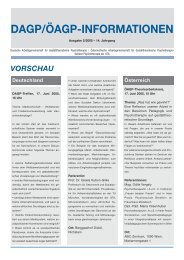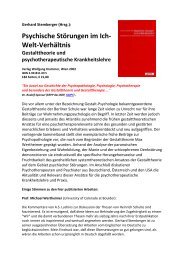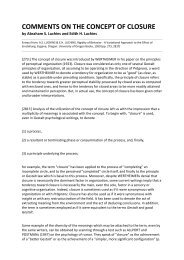pdf-Download - Society for Gestalt Theory and its Applications (GTA)
pdf-Download - Society for Gestalt Theory and its Applications (GTA)
pdf-Download - Society for Gestalt Theory and its Applications (GTA)
Create successful ePaper yourself
Turn your PDF publications into a flip-book with our unique Google optimized e-Paper software.
3) The problem of the relation between the situation <strong>and</strong> motorics, which is the basis of<br />
behaviour.<br />
The alternative to the statement that all larger complexes in the psychological sphere result from<br />
the connection of elementary facts is not the statement that, in the psychic life, "everything is<br />
interconnected" at the beginning <strong>and</strong> that, only in time, by means of maturation <strong>and</strong> learning<br />
processes, this universal interconnection is gradually split up <strong>and</strong> resolved (William JAMES, Hans<br />
CORNELIUS, Felix KRUEGER, Heinz WERNER).<br />
The alternative is rather an assumption that the development <strong>and</strong> learning proesses :<br />
a) split up <strong>and</strong> resolve existing larger complexes,<br />
b) combine existing small complexes, which, in extreme cases, may have the character of<br />
elements, into larger complexes, <strong>and</strong><br />
c) that existing structures may change into others by simultaneous resolving <strong>and</strong> reombining.<br />
In such a psychology, too, the question arises as to whether one of these processes is primary <strong>and</strong>,<br />
if this is the case, which one. Here only the following is certain:<br />
1) in the sphere of motorics, the primary process of development is the process a), the splitting or<br />
differentiation of the originally total motion patterns which employ all available muscles,<br />
(COGHILL).<br />
2) similarity, in establishing the structure of the surrounding world, the primary one is not the<br />
problem of combining "un<strong>its</strong>" but rather that of establishing boundaries, that means, again, the<br />
problem of differentiation.<br />
3) on the other h<strong>and</strong> - at least in the case of man - the secondary connection between situations<br />
<strong>and</strong> activities in the sense of behaviourism seems to be the more frequent or perhaps the main<br />
means of change even when, as the possibility of extinction of existing connections proves, not the<br />
only one.<br />
6. On the Principle of Contiguity or Contact<br />
Contact or time-space vicinity is an important but neither a sufficient nor necessary condition <strong>for</strong><br />
the <strong>for</strong>mation of connections.<br />
It is not sufficient. The perception field is a continuum without gaps. Thus, the problem arising<br />
here may be verbalized in the following way: how is it possible that two processes A, B, taking<br />
place in an immediate contact with each other, <strong>for</strong>m a unity whereas two processes B, C, taking<br />
place in an immediate contact with each other as well differentiate from each other. Apparently,<br />
other principles must be involved.<br />
The same as has been said about the primary field differentiation may be repeated in the case of<br />
association experiments. Under completely identical time-space conditions, very different<br />
numbers of repetitions are needed in order to establish a connecion independent of the materials<br />
which are to be connected. In addition, the durability of such connections is very different. Even in<br />
this case it is not possible to speak of an exclusive effectiveness of the space-time factor.<br />
8


